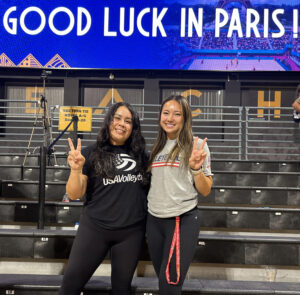08.09.2024
By uscbknpt
Readying Team USA Volleyball for Paris

While gaining valuable experience with wearable tech and sports science data, eight USC graduate students from the Division of Biokinesiology and Physical Therapy helped USA Volleyball’s senior national teams prepare for the 2024 Summer Olympics.
BY DANIEL P. SMITH
FOR 8 USC STUDENTS, the recent Olympic games in Paris — and, specifically, the performances of the USA’s men’s and women’s volleyball teams — were of great personal interest.
Over recent months, the eight students — five from the doctor of physical therapy (DPT) program and three from the master of science in biokinesiology (MS BKN) program — helped prepare Team USA Volleyball’s senior indoor national teams for competition in Paris while simultaneously gaining valuable exposure to sports science data and its ties to athletic performance.
“For our students, this was a rich and unique opportunity to work with wearable tech in a professional sports setting with the added benefit of preparing our athletes for the Olympic games,” says program coordinator Amanda Preciado MS BKN ’21, who oversaw the students’ efforts with USA Volleyball.
Driving athlete performance
In the months leading up to the teams’ departure for France, the USC contingent attended daily practices in Anaheim, Calif., where they laid out Catapult T7 vests for the athletes to wear during their training. The Catapult system features LPS (local positioning system) technology, which captures and communicates advanced tracking and positioning data for each athlete.
The students then monitored the trainings live, tracking and analyzing athletes’ external parameter outputs and sharing data with members of the coaching staff and medical team. On the volleyball court, Preciado says the relevant data isn’t necessarily distance covered, as it might be with a soccer player, but rather the athletes’ high-intensity movements, principally jump count and high-intensity player load.
While coaching and performance staff often have a good idea of how they want to organize a training session based on technical or tactical needs, a system like Catapult delivers numeric values to the training themes to drive preparation and performance. For the women’s national team, for example, athletes had defined targets to hit each day — prescribed figures designed to get athletes game ready while limiting the risk of injury caused by over- or undertraining.

“Our ultimate goal was to help the athletes be as prepared as possible,” says Giuliet Kibler MS BKN ’25, who helped manage student activity at practices alongside Preciado and called the opportunity to work with USA Volleyball eye-opening and rewarding. “I wasn’t aware of sports science as a topic until I arrived at USC, so this was entirely new for me. It was so beneficial to see what this looks like in real life and how it translates to supporting athlete performance.”
Along the way, students increased their sports science data literacy, observed the collaborative, multidisciplinary environment now commonplace in high-level athletics, and learned about structuring programs and interventions based on objective data from wearable tech, something especially valuable for the DPT students, according to Preciado.
“Working with athletes trying to return to competition, you can better understand what the numbers mean and how to bring athletes back from injury and help them through their rehab process,” she says.
Lessons learned
While MS BKN students had been working with USA Volleyball for the past two years, Preciado and Susan Sigward PhD ’04, director of the MS BKN and sport science programs, extended the opportunity to DPT students earlier this year, thinking some would be interested in learning about sports science and wearable tech, including its potential applicability in physical therapy and rehab settings.
“Ultimately, sports science and physical therapy professionals are going to be working hand in hand,” Sigward says of the benefit of the sports science program to DPT students. “The future is about using data and technology to optimize movement and recovery and preserve function. Allowing DPT students to get exposure to this expanding area will prepare them to thrive in this model.”

Ravin Rhodes DPT ’26 was one of the five DPT students who participated in the effort. A former collegiate volleyball player, Rhodes cherished the opportunity to work with accomplished athletes representing Team USA. She found the detailed collaboration of professionals and their unwavering commitment to driving athlete and team performance inspiring.
“In the clinic, we don’t get to see a patient’s whole medical team work together, so seeing it live in real time was amazing,” Rhodes says. “And seeing how all these amazing professionals put their knowledge and experience together was awesome.”
Tia Butler DPT ’26 similarly enjoyed seeing the cohesion and communication among professionals supporting the national teams, though she also appreciated the opportunity to explore the rising value of kinesiology-related technologies.
“The attitude in the gym was always great, and working with both teams has not only deepened my love for sports but also expanded my understanding of sports science and its critical role in athlete development and rehabilitation,” Butler says.
Ultimately, sports science and physical therapy professionals are going to be working hand in hand. … Allowing DPT students to get exposure to this expanding area will prepare them to thrive in this model.
—Susan Sigward, Director of the Master’s in Biokinesiology Program
Another student, Olivia Tu DPT ’26, says working with USA Volleyball elevated her understanding of sports data tracking systems and the technology’s applicability in clinical practice.
“Working with USA Volleyball has shown me the huge benefit sports science technology has in helping athletes,” Tu says. “I learned how beneficial it is to have sports data tracking systems to help athletes stay healthy, constantly improve and ramp up for games.”
And for Maureen Rodick DPT ’26, who grew up an athlete with countless questions about training, performance, recovery and strategy, helping some of the nation’s greatest athletes prepare for international competition was exciting and only intensified her desire to be involved with athletes as a physical therapist. Yet more, she’s confident the practical understanding of the concepts and tools for assessing and interpreting sports performance data she developed during her time with USA Volleyball will serve her well in her career.
“Using the knowledge I have gained, I will now be able to apply it in real-world settings and communicate effectively with members of multi-disciplinary teams dedicated to athlete performance, rehabilitation and overall well-being,” Rodick says.

